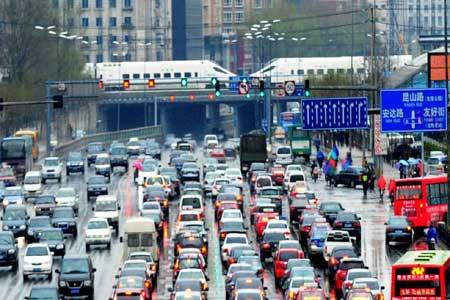
A traffic jam in Shenyang, Liaoning province. The majority of China's intelligent transportation sector is currently driven by government-led projects. Hai Tao / for China Daily
Domestic, international firms hone in on IT-leveraged road managementBEIJING - China has witnessed a rapid increase in the number of vehicles plying the nation's highways over the last few years, which inevitably bring with them traffic jams and accidents.
Now, many companies have found a way to cash in on these very problems, including both international firms and homegrown startups. How? Via an intelligent transportation system (ITS) that uses information and communications technology to manage vehicles, loads and routes, presenting a big market in a rapid-developing China.
ITS covers a wide range of applications related to city traffic management and highway management, such as electronic toll collection, dynamic traffic light sequencing, automatic road enforcement and road condition alerts.
"It's an emerging market in China and the need is really big," said Troy Mao, chief financial officer of China TransInfo Technology Corp, a Nasdaq-listed ITS service provider based in Beijing.
The company, which has seven subsidiaries specializing in different fields of ITS, expects its revenue this year to reach $120 million, almost double the $63.7 million the firm took in last year.
It is now working with the Ministry of Transport to launch a fleet management system across the country. With this system, certain vehicles real-time status, such as gasoline consumption, load and position, can be monitored and sent to a national database.
"ITS, as a way to manage and facilitate transportation, will probably come as the next big thing after the country inputs a lot into infrastructure," added Mao.
The Chinese government unveiled a 4 trillion yuan stimulus package in November 2008, 1.5 trillion yuan of which went to infrastructure investment, including railroads, highways and airports.
According to the Ministry of Transport, China's highways span 3.7 million kilometers, of which, expressways take up 65,000 kilometers, ranking second in the world. The ministry expects that the mileage of China's expressways will surpass that of the United States in the next two to three years.
Though in the early stages, the ITS market, especially that related to city traffic management, has been a revenue generator for some companies.
Hanwang Technology Co Ltd, the country's largest electronic handwriting recognition company, said that two-thirds of its ITS revenue came from city traffic management, such as license-plate recognition and speed limit infractions. Profit of Hanwang's ITS business rose 30 percent from 2008 to reach 40 million yuan last year.
"The coming three to five years will see more rapid development of the industry," said Zhang Kaichun, vice-president of Hanwang.
According to domestic research firm CCW research, China's ITS market hit 18 billion yuan last year, with a year-on-year increase of 27 to 30 percent.
Meanwhile, according to industry experts, ITS made up some 7 to 10 percent of total transportation investment in some developed countries, while in China it is just around 1 percent. The potential of China's ITS market has not been fully tapped.
In recent years, more and more companies have sought inroads into the sector. According to CCW research, there are about 1,000 companies of various sizes in the field.
Yet few of these companies have developed into one with national influence.
"There are barriers in different parts of China," said Zhao Xinlong, vice-president of the transportation division of Neusoft Corporation, a Chinese software-outsourcing firm.
The majority of ITS business is currently driven by government-led projects, and since local governments tend to support local companies, it may be difficult for outside firms to enter an area, he added.
But he said that setting up subsidiaries locally helps reduce obstacles. Some ITS providers, such as China TransInfo and Neusoft, have established branches in different places to better cash in on local markets.
"A large number of acquisitions are very likely to take place in the next one to two years, and this may make the splintered market concentrated," said Peng Haixiang, an analyst with CCW Research.





